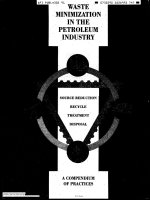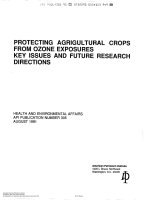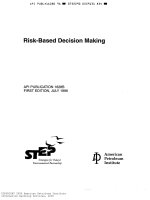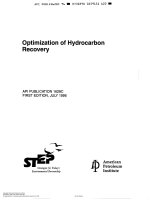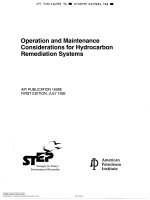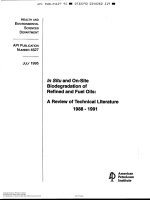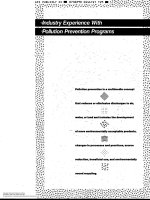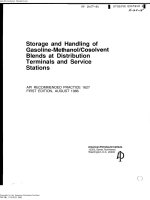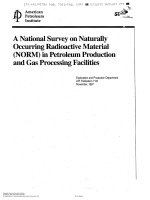Api dr 148 1997 scan (american petroleum institute)
Bạn đang xem bản rút gọn của tài liệu. Xem và tải ngay bản đầy đủ của tài liệu tại đây (1.66 MB, 63 trang )
-
~~
-
American
Petroleum
Institute
IDENTIFICATION
OF
ORGANIC
TOXICANTS
IN
TREATED
REFINERY
EFFLUENTS
Health and Environmental Sciences Department
Publication Number DR 148
December 1997
--`,,-`-`,,`,,`,`,,`---
Copyright American Petroleum Institute
Provided by IHS under license with API
No reproduction or networking permitted without license from IHS
STD.API/PETRO
~
DR L q 8 - E N G L 1997
Not for Resale
~~
0732290 0 6 0 4 b 0 0 5 7 7 9
~~
~
P
American
Petroleum
Institute
American Petroleum Institute
Environmental, Health, and Safety Mission
and Guiding Principles
MISSION
PRINCIPLES
The members of the American Petroleum Institute are dedicated to continuous efforts
to i m p m e the compatibility of our opemtwns with the envimnment while
economically developing energy resoutres anà supplying high quality pmducrs and
services to consumers. We recognize our responsibility to work with the public, the
government, and others to develop and to use natural resources in an
envimnmentally sound manner while pmtecting the health and safety of our
employees and the public. To meet these responsibilities, API members pledge to
manage our businesses according to -the following principles using sound science to
prioritize risks and to implement cost-Mective management practices:
o
0
o
To recognize and to respond to community concerns about our raw materials,
products and operations.
To operate our plants and facilities,and to handie our raw materials and products
in a manner that protects the environment, and the safety and health of our
employees and the public.
To make safety, health and environmental considerations a priority in our
planning, and our development of new products and processes.
0
I
To advise promptly, appropriate officials, employees, customers and the public of
information on significant industry-related safety, health and environmental
hazards, and to recommend protective measures.
o
To counsel customers, transporters and others in the safe use, transportation and
disposal of our raw materials, products and waste materiais.
o
To economically develop and produce naturai resources and to conserve those
resources by using energy efficiently.
o
To extend knowledge by conducting or supporting research on the safety, health
and environmental effects of our raw materials, products, processes and waste
materials.
o
To commit to reduce overail emission and waste generation.
o
To work with others to resolve problems created by handling and disposal of
hazardous substances from our operations.
o
To participate with government and others in creating responsible laws,
regulations and standards to safeguard the community, workplace and
environment.
o
To promote these principles and practices by sharing experiences and offering
assistance to others who produce, handle, use, transport or dispose of similar raw
materiais, petroleum products and wastes.
--`,,-`-`,,`,,`,`,,`---
Copyright American Petroleum Institute
Provided by IHS under license with API
No reproduction or networking permitted without license from IHS
Not for Resale
Identification of Organic Toxicants in
Treated Refinery Effluents
Health and Environmental Sciences Department
API PUBLICATION NUMBER DR 148
PREPARED UNDER CONTRACT BY:
ASCICORPORATION/ASCI-DULUTH
ENVIRONMENTAL
TESTINGDIVISION
112 EASTSECOND
STREET
55805
DULUTH,
MINNESOTA
DECEMBER 1997
I
--`,,-`-`,,`,,`,`,,`---
Copyright American Petroleum Institute
Provided by IHS under license with API
No reproduction or networking permitted without license from IHS
Not for Resale
American
Petroleum
Institute
~-
~
~
~~~
~
S T D - A P I / P E T R O DR 148-ENGL 1997
~
0732290 0 6 0 4 6 0 3 286 W
FOREWORD
API PUBLICATIONS NECESSARILY ADDRESS PROBLEMS OF A GENERAL
NATLTRE. WITH RESPECT TO PARTICULAR CIRCUMSTANCES, LOCAL, STATE,
AND FEDERAL LAWS AND REGULATIONS SHOULD BE REVIEWED.
API IS NOT UNDERTmG TO MEET THE DUTIES OF EMPLOYEiRS, W A C TURERS, OR SUPPLIERSTO WARN AND PROPERLY TRAIN AND EQUIP THEIR
EMPLOYEES, AND OTHERS EXPOSED, CONCERNING HEALTH AND SAFETY
RISKS AND PRECAUTIONS, NOR UNDERTAKING THEIR OBLIGATIONSUNDER
LOCAL, STATE, OR FEDERAL LAWS.
NOTHING CONTAINED IN ANY API PUBLICATION IS TO BE CONSTRUED AS
GRANTING ANY RIGHT, BY IMPLICATION OR OTHERWISE, FOR THE MANUFACTURE, SALE, OR USE OF ANY METHOD, APPARATUS, OR PRODUCT COVERED BY LETTERS PATENT. NEITHER SHOULD ANYTHING CONTAINED IN
THE PUBLICATION BE CONSTRUED AS INSURING ANYONE AGAINST LIABILITY FOR INFRINGEMENT OF LETTERS PATENT.
AI1 righrs reserved. No part of this work may be reproduced, stored in a retrieval system, or transmitted by any
means,electmnic, mechanical, photocopying, recording, or otherwise. without priÒr written permission from the
publisher Contact the publisher. API Publishing Services, 1220 L Street, N. W ,Washington, D.C. 20005.
Copyright Q 1997 American Petroleum institute
iii
--`,,-`-`,,`,,`,`,,`---
Copyright American Petroleum Institute
Provided by IHS under license with API
No reproduction or networking permitted without license from IHS
Not for Resale
ACKNOWLEDGMENTS
THE FOLLOWING PEOPLE ARE RECOGNIZED FOR THEIR CONTRIBUTIONS OF
TIME AND EXPERTISE DURING THIS STUDY AND IN THE PREPARATION OF
THIS REPORT:
API STAFF CONTACT
Alexis Steen, Health and Environmental Sciences Department
MEMBERS OF THE BIOMONITORING TASK FORCE
Philip B. Dorn, Ph.D., Shell Development Company (Chairman)
W.Raymond Arnold, Ph.D., Exxon Biomedical Sciences, Inc.
Marie T. Benkinney, Mobil Oil Corporation
Janis M. Farmer, BP America R&D
William R. Gala, Ph.D., Chevron Research and Technology Company
Jerry F. Hail, Ph.D., Texaco Research
Michael D. Harrass, Ph.D., Amoco Corporation
Denise J. Jett, Phillips Petroleum Company
Eugene R. Mancini, Ph.D., ARCO
James E. O’Reilly, Exxon Production Research Company
Lawrence A. Reitsema, Ph.D., Marathon Oil Company
C. Michael Swindoll, Dupont Environmental Remediation Svc.
Michael E. Tucker, Occidental Chemical Company
Carl Venzke, Citgo Petroleum Corporation
The Biomonitoring Task Force also acknowledges the editorial support from Karen Inman,
Pamela Greene, and Suzanne Covello at API.
--`,,-`-`,,`,,`,`,,`---
Copyright American Petroleum Institute
Provided by IHS under license with API
No reproduction or networking permitted without license from IHS
Not for Resale
~~~
~
~~
STD.API/PETRO
DR L48-ENGL
1997
0732270 Ob04b05 057
ABSTRACT
In this study, effluents from five oil refineries were examined for the presence of nonpolar,
organic chronic toxicity following suggested U.S. EPA guidelines for Phase I Toxicity
Characterization procedures. The refinery effluent containing the most toxicity from nonpolar
organic toxicants was selected for more detailed analyses and identification of these toxicants
using Phase II procedures. Extraction and elution conditions were modified to increase
chronic toxicity recovery and also reduce the complexiv of the nonpolar organic effluent
fraction containing toxicity.
Results showed that simple modifications of U.S. EPA guidance for C,, solid phase extraction
(SPE) procedures combined with proper toxicity testing conditions successfully tracked and, to
an acceptable degree, isolated toxicity in an effluent fraction amenable for identification of
suspected nonpolar organic toxicants. Toxicity was observed only in 100% effluent
concentrations, not in dilutions of the effluents. Further chronic toxicity was not consistently
Findings from this study indicated that sources of refinery effluent toxicants were a phenol
associated with a jet fuel additive and two brominated organics believed to be reaction
products of cooling tower water treatment chemicals, rather than from crude oil constituents.
Copyright American Petroleum Institute
Provided by IHS under license with API
No reproduction or networking permitted without license from IHS
Not for Resale
--`,,-`-`,,`,,`,`,,`---
observed in the effluent fractions.
.
~~~
~~
~
STDDAPIIPETRO DR 148-ENGL 1997
0732290 ObOYbOb T95
=
TABLE OF CONTENTS
pane
Section
. . . . . . . . . . . . . . . . . . . . . . . . . . . . . . . . . . . . e5-1
INTRODUCTION . . . . . . . . . . . . . . . . . . . . . . . . . . . . . . . . . . . . . . . . . . . 1-1
BACKGROUND . . . . . . . . . . . . . . . . . . . . . . . . . . . . . . . . . . . . . . . 1-1
OBJECTIVES AND SCOPE . . . . . . . . . . . . . . . . . . . . . . . . . . . . . . .
1-2
METHODS . . . . . . . . . . . . . . . . . . . . . . . . . . . . . . . . . . . . . . . . . . . . . . . .
2-1
GENERAL APPROACH . . . . . . . . . . . . . . . . . . . . . . . . . . . . . . . . . .
2-1
INITIAL TOXICITY SCREENS . . . . . . . . . . . . . . . . . . . . . . . . . . . .
2-1
Fathead Minnow Tests . . . . . . . . . . . . . . . . . . . . . . . . . . . . . . 2-1
Mysid Tests . . . . . . . . . . . . . . . . . . . . . . . . . . . . . . . . . . . . . . 2-2
EXECUTIVE SUMMARY
2
....................................
PHASE II cl8 SPE METHODS . . . . . . . . . . . . . . . . . . . . . . . . . . . . .
C.. SPE Sorption and Elution . . . . . . . . . . . . . . . . . . . . . . . . . .
Concentration of Toxic Phase II Fractions . . . . . . . . . . . . . . . . .
HPLC Separation Techniques . . . . . . . . . . . . . . . . . . . . . . . . . .
GCMS Methods . . . . . . . . . . . . . . . . . . . . . . . . . . . . . . . . . .
RESULTS . . . . . . . . . . . . . . . . . . . . . . . . . . . . . . . . . . . . . . . . . . . . . . . . .
PHASE I RESULTS FOR SELECTED REFINERY EFFLUENTS . . . . .
PHASE II NONPOLAR ORGANIC TOXICITY IDENTIFICATION . . . .
PHASE I METHODS
3
pH Modifications of the Effluent Prior to
cl8
2-2
2-2
2-3
2-3
2-4
2-5
3-1
3-1
3-6
Sorption . . . . . . . . . 3-7
Modification of the Standard Phase II Elution Sequence . . . . . . . . 3-9
PHASE III TOXICITY CONFIRMATION . . . . . . . . . . . . . . . . . . . . .
...............................
4 SUMMARY . . . . . . . . . . . . . . . . . . . . . . . . . . . . . . . . . . . . . . . . . . . . . . .
REFERENCES . . . . . . . . . . . . . . . . . . . . . . . . . . . . . . . . . . . . . . . . . . . . .
Toxicant Variability
Copyright American Petroleum Institute
Provided by IHS under license with API
No reproduction or networking permitted without license from IHS
Not for Resale
3-16
3-22
4-1
R-1
--`,,-`-`,,`,,`,`,,`---
1
~~
STD.API/PETRO
DR 1 4 8 - E N G L
2997
m
0732290 Ob04607 921
m
LIST OF FIGURES
Figure
3-1 GCMS Scans of pHi, pH 3.0, and pH 9.0 100% Methanol Toxic Phase II Fraction
Concentrates, Refinery #1 - Sample I . . . . . . . . . . . . . . . . . . . . . . . . . . . . . . . .
3-8
3-2 Comparison of U.S. EPA and Modified Scheme Used in This Study for
Identification of Nonpolar Toxicants . . . . . . . . . . . . . . . . . . . . . . . . . . . . . . . 3-10
3-3 GCMS Total Ion Chromatogram of Toxic 100% Methanol Fraction Concentrate,
Refinery #1 - Sample I . . . . . . . . . . . . . . . . . . . . . . . . . . . . . . . . . . . . . . . .
3-13
3-4 GC/MS Total Ion Chromatogram for the First Toxic 100% Methanol Fraction
Concentrate, Refinery #1 - Sample I . . . . . . . . . . . . . . . . . . . . . . . . . . . . . . . 3-14
3-5 GC/MS Total Ion Chromatogram for the Second Toxic 100% Methanol Fraction
Concentrate, Refinery #1 - Sample I . . . . . . . . . . . . . . . . . . . . . . . . . . . . . . .
3-15
3-6 GCMS Chromatogram for 58 mg/L 2,4 ditert-butyl phenol and Toxic Fraction
Concentrate, Refinery #1 - Sample I . . . . . . . . . . . . . . . . . . . . . . . . . . . . . . . 3-17
3-7 HPLC Chromatogram for 58 mg/L 2,4 ditert-butyl phenol and Toxic Fraction
Concentrate, Refinery #1 - Sample I . . . . . . . . . . . . . . . . . . . . . . . . . . . . . . . 3-18
3-8 G C N S Total Ion Chromatogram of the 90% Methanol Fraction Concentrate
of Jet Fuel Additive A and Identified Peaks ..........................
3-19
3-10 G C N S Total Ion Chromatogram of the Combined 95% and 100% Methanol
Fraction Concentrate of Jet Fuel Additive B and Tentatively Identified Peaks . . . 3-21
3-1 1 GCMS Total Ion Chromatogram of Simplified Toxic C,, SPE Fraction
Concentrate, Refinery #1 - Sample II . . . . . . . . . . . . . . . . . . . . . . . . . . . . . . . 3-23
3-12 G C N S Total Ion Chromatogram of Simplified Toxic C,, SPE Fraction
Concentrate, Refinery #1 - Sample III . . . . . . . . . . . . . . . . . . . . . . . . . . . . . . 3-24
3-13 GC/MS Total Ion Chromatogram of Toxic Eluates Before and After Phase II
Separation, Refinery #1 - Sample I . . . . . . . . . . . . . . . . . . . . . . . . . . . . . . . .
3-25
3-14 GC/MS Total Ion Chromatogram of Toxic Eluates Before and After Phase II
Separation, Refinery #1
Copyright American Petroleum Institute
Provided by IHS under license with API
No reproduction or networking permitted without license from IHS
- Sample II . . . . . . . . . . . . . . . . . . . . . . . . . . . . . . . .
Not for Resale
3-26
--`,,-`-`,,`,,`,`,,`---
3-9 GCMS Total Ion Chromatogram of the 95% Methanol Fraction Concentrate
of Jet Fuel Additive A and Identified Peaks . . . . . . . . . . . . . . . . . . . . . . . . . . 3-20
-~
~-
STD.API/PETRO
DR 148-ENGL 1377
= 0732270 Ob04608
~-
868
3-15 GC/MS Total Ion Chromatogram of the Concentrated Toxic HPLC Fraction
Concentrate. Refinery #1 .Sample IV . . . . . . . . . . . . . . . . . . . . . . . . . . . . . . 3-27
.Sample IV . . . . . . . . .
3-28
.........
3-29
3-18 Mass Spectrum of Peak at 31.066 Minutes. Refinery #1
.Sample IV . . . . . . . . .
3-30
3-19 Mass Spectrum of Peak at 31.835 Minutes. Refinery #1
.Sample IV . . . . . . . . .
3-31
3-20 Mass Spectrum of Peak at 44.587 Minutes. Refinery #1
.Sample IV . . . . . . . . .
3-32
3-16 Mass Spectrum of Peak at 25.301 Minutes. Refinery #1
3-17 Mass Spectrum of Peak at 26.350 Minutes. Refinery #1 .Sample IV
3-21 GCMS Total Ion Chromatogram of HPLC Fraction #11. Refinery #1 .
SampleV . . . . . . . . . . . . . . . . . . . . . . . . . . . . . . . . . . . . . . . . . . . . . . . . . 3-34
3-22 GCMS Total Ion Chromatogram of HPLC Fraction #12. Refinery #1 .
SampleV . . . . . . . . . . . . . . . . . . . . . . . . . . . . . . . . . . . . . . . . . . . . . . . . .
3-35
3-23 Mass Spectrum of Peak at 25.384 Minutes with Breakdown of
Chemical Components . . . . . . . . . . . . . . . . . . . . . . . . . . . . . . . . . . . . . . . . .
3-36
3-24 Mass Spectrum of Peak at 31 .042 Minutes with Breakdown of
Chemical Components . . . . . . . . . . . . . . . . . . . . . . . . . . . . . . . . . . . . . . . . .
3-37
3-25 Structures of Brominated Compounds in Refinery #1 .Samples IV and V
--`,,-`-`,,`,,`,`,,`---
Copyright American Petroleum Institute
Provided by IHS under license with API
No reproduction or networking permitted without license from IHS
Not for Resale
. . . . . 3-38
LIST OF TABLES
Table
3- 1 Chronic Phase I Toxicity Characterization Results for Fathead Minnows
Exposed to Refinery #1 Final EMuent . . . . . . . . . . . . . . . . . . . . . . . . . . . . . . . 3-2
3 -2 Chronic Phase I Toxicity Characterization Results for Fathead Minnows
Exposed to Refinery #2 Final EMuent . . . . . . . . . . . . . . . . . . . . . . . . . . . . . . .
3-3
3-3 Chronic Phase I Toxicity Characterization Results for Mysids Exposed to
Refinery #3 Final EMuent . . . . . . . . . . . . . . . . . . . . . . . . . . . . . . . . . . . . . . . 3-4
3-4 Chronic Phase I Toxicity Characterization Results for Mysids Exposed
to Refinery #4 Final Effluent . . . . . . . . . . . . . . . . . . . . . . . . . . . . . . . . . . . . . 3-5
3-5 Percentage Survival of Fathead Minnows in cl8 Concentrate Made from
Effluent That Had Aged for 12 and 19 Days . . . . . . . . . . . . . . . . . . . . . . . . . . . 3-6
3-6 Refinery #1, Fathead Minnow Survival from cl8 SPE Tests Employing pH
Adjustment Before Extraction . . . . . . . . . . . . . . . . . . . . . . . . . . . . . . . . . . . . .
3-7
3-7 Refinery #3, Mysid Percent Survival in C,, Eluate Employing pH
Adjustment Before Elution . . . . . . . . . . . . . . . . . . . . . . . . . . . . . . . . . . . . . . . 3-7
3-8 Mysid Percent Survival in Eight Fractions Eluated from C,, SPE
Columns Using Effluent from Refinery #3 . . . . . . . . . . . . . . . . . . . . . . . . . . . . 3-9
--`,,-`-`,,`,,`,`,,`---
3-9 Fathead Minnow Percent Survival in Eight Eluates from C,, SPE
Columns Using EMuent from Refinery #3 . . . . . . . . . . . . . . . . . . . . . . . . . . . 3-1 1
3-10 Fathead Minnow Percent Survival in Five Eluates from a C,, SPE Column
That Had Previously Been Eluted with 25 and 50% Methanol Using Refinery #1
Copyright American Petroleum Institute
Provided by IHS under license with API
No reproduction or networking permitted without license from IHS
Not for Resale
.
3-1 1
~~~
~~
STD.API/PETRO
DR 1 4 8 - E N G L
1997
0732290 0604bLO 416
EXECUTIVE SUMMARY
Prior to the passage of the Federal Water Pollution Control Act (PL 92-500; Clean Water Act)
in 1972, refinery wastewater treatment systems were diverse in design and treatment
effectiveness. Engineering- and technology-based treatment standards, initially developed
under the Act to achieve prescribed effluent concentrations resulted in treatment system
upgrades and improved wastewater quality. A subsequent EPA initiative to implement waterquality-based effluent limitations (49 Federal Register 9016), as measured by effluent and
receiving water aquatic toxicity tests, substantiaily expanded and enhanced aquatic toxicity
testing capabilities. During this same period, advancements in analytical chemistry and
toxicity identification procedures helped identi@ refinery wastewater constituents and
treatment processes which were responsible for observed toxicity. Treatment system upgrades
designed to achieve these water-quality-based objectives further improved effluent quality.
This investigation represents the next level of sophistication in effluent quality assessments
and similarly reflects a substantial change in the nature and magnitude of refinery effluent
toxicity. The focus of this study was the isolation and identification of nonpolar, organic
wastewater constituents causing measurable, chronic toxicity in treated refinery effluent.
Nonpolar organic toxicants were operationally defined as those adsorbed by
cl8
solid phase
extraction (SPE) columns. Effluents from five refineries were selected for screening-level
toxicity assessments.
Isolation and identification of the organic compounds responsible for the observed toxicity
were accomplished after modifications were made to existing toxicity characterization and
identification guidance. Specifically, effluent extraction and elution conditions were modified
to reduce the complexity of the organic fraction and to increase recovery efficiency of the
chronically toxic fraction. One avenue examined was adjustment of effluent pH before
extraction using
cl8
columns. Another avenue was modification of the standard Phase II
column elution scheme suggested by the U.S. EPA guidance for performing Toxicity
Identification Evaluations (TIES).
ES-]
--`,,-`-`,,`,,`,`,,`---
Copyright American Petroleum Institute
Provided by IHS under license with API
No reproduction or networking permitted without license from IHS
Not for Resale
cl8
-
~
STD.API/PETRO
~
DR 148-ENGL 1997
m
0732290 ObO4b11 352
m
The toxicants were neither derived from crude oil or refined product nor were they
conventional pollutants associated with refinery wastewater treatment systems. The identified
toxicants were a phenol associated with a jet fuel additive and two aromatic brominated
organics, believed to be reaction products of cooling tower water treatment chemicals. These
compounds exhibited variable, intermittent, and low concentration toxicity and their
identification required enhanced fractionation procedures.
None of the effluents tested had sufficient concentrations of total dissolved solids, ammonia,
or hydrogen sulfide to be of concern for causing chronic toxicity or interfering with
examination of the contribution by nonpolar compounds. Only one of five refinery effluents
exhibited organic toxicity of sufficient magnitude to allow subsequent attempts at toxicant
isolation and identification. Additionally, levels of chronic toxicity were generally found to
be low. These results constitute a broader demonstration of the significant progress during the
last 20+ years in refinery wastewater treatment as well as effluent toxicity characterization and
identification.
Improvements in refinery effluent quality have been accomplished through treatment
enhancements and through better housekeeping practices. Substances such as total dissolved
solids, ammonia and hydrogen sulfide, formerly recognized as causing toxicity in refinery
effluents, have been largely brought under control. Thus, acute toxicity in refinery effluents
is often absent. Chronic toxicity often occurs only at higher effluent concentrations, as
demonstrated in this study. Which levels of toxicity are considered of importance in the
receiving water depends on the amount and rate of dilution that occurs in the receiving
stream. Dilution allowance in the receiving water is usually recognized by regulatory
authorities. The type and amount of toxicity identified in this study would be of concern only
where available dilution was very low.
ES-2
--`,,-`-`,,`,,`,`,,`---
Copyright American Petroleum Institute
Provided by IHS under license with API
No reproduction or networking permitted without license from IHS
Not for Resale
~~
STD.API/PETRO
~
DR L4ô-ENGL 1997
m 0732290
Ob04bL2 299
m
Section 1
INTRODUCTION
BACKGROUND
The convergent evolution of aquatic toxicity testing, analytical chemistry, and refinery
wastewater engineering has progressed through several levels over the years. Whole effluent
aquatic toxicity tests conducted early in this evolutionary process found acute toxicity at
relatively low effluent concentrations. These discharges were, and continue to be, complex in
chemical composition, and the nature and extent of their toxicity are variable. Prominent
inorganic and organic constituents previously identified as responsible for acute andor chronic
toxicity were ammonia, total dissolved solids (TDS), and napthenic acids. Combinations of
test species selection and test conditions, treatment system operations and refinery wastewater
stream characteristics all played roles in affecting effluent quality. As influences of these
conditions were more clearly understood and appropriate enhancements made, the incidence
and extent of acute effluent toxicity have generally declined.
More sensitive subacute tests were developed to identify effluent toxicity, which was usually
observed at higher effluent concentrations. Treatment system design and operation were also
improved to reduce or eliminate sporadic toxicity (e.g., ammonia excursions). Experience
illustrated that attention to treatment system operational details and wastewater stream quality
(i.e., refinery unit operation) could reduce whole effluent toxicity.
Even after the many improvements that have been made, the more sensitive toxicity tests
concentrations. The importance of this toxicity to natural receiving systems depends on the
degree of dilution occurring. In most situations, sufficient dilution is available in the
receiving water. When dilution in the receiving water is very low, regulatory authorities may
insist on further toxicity reduction. It was anticipated that nonpolar organic compounds from
refinery processes were in the final effluent and would be frequently contributing to
observations of chronic toxicity. Information about such toxicants was desired to provide a
1-1
Copyright American Petroleum Institute
Provided by IHS under license with API
No reproduction or networking permitted without license from IHS
Not for Resale
--`,,-`-`,,`,,`,`,,`---
(largely chronic tests) sometimes reveal measurable chronic toxicity at higher effluent
~
STD.API/PETRO
~
~~
DR 148-ENGL 1997
m
0732290 0 6 0 4 6 1 3 125
=
better understanding of their contribution to refinery effluent toxicity and to direct efforts
towards control andor reduction. The EPA TIE procedures were used and modified to
identi@ the small amounts of toxicity caused by nonpolar organic compounds in refinery
effluents.
OBJECTIVES AND SCOPE
Toxicity characterization procedures with either larval fathead minnow (Pimephalespromelus)
or (Mysidopsis bahia) were performed with effluents from five refineries to identi6 nonpolar
organics responsible for chronic toxicity. Test species selected for this study are also
commonly used for determining compliance with effluent discharge toxicity limits. Any
toxicity caused by more easily recognized substances, such as ammonia, was not of concern.
Characteristics of selected refinery effluents were initially examined to determine suitable
effluents for identification of nonpolar organic toxicants. Nonpolar organic toxicants were
operationally defined as those adsorbed by C,, SPE columns. Desirable effluent
characteristics were: 1) consistent presence of measurable chronic toxicity due to nonpolar
organic compounds; and 2) a lack of toxicity from compounds other than nonpolar organics.
Samples with these characteristics were preferred to minimize difficulties in tracking effluent
toxicity through sample manipulations and to reduce the possibility of artifacts from the
multiple treatments required to address toxicants belonging to more than one class of
compounds.
Historically, several common difficulties have been encountered during identification of
nonpolar organic toxicants in refinery effluents. Past problems included: 1) poor recovery of
toxicity from C,, solid phase extraction (SPE) columns, 2) poor resolution of toxicity during
separative steps, 3) failure to recover toxicity following high performance liquid
chromatography (HPLC) separation, and 4) inability to adequately simplifi effluent fractions
containing the nonpolar organic toxicants. Procedures were employed to: 1) simplify the toxic
nonpolar organic effluent fraction, 2) achieve sufficient toxicant concentration to allow
analytical measurement, and 3) remove water from the fraction to allow analysis by gas
1-2
--`,,-`-`,,`,,`,`,,`---
Copyright American Petroleum Institute
Provided by IHS under license with API
No reproduction or networking permitted without license from IHS
Not for Resale
~~
STD.API/PETRO
DR 148-ENGL 1977
m 0732270
~
ObOLibL4 O b L
~~
m
chromatography/mass spectroscopy (GUMS). GC analyses are often not definitive because of
the hydrocarbon content of refinery effluents. To overcome these difficulties, modifications
of the U.S. EPA’s suggested guidance for Phase II Toxicity Identification Evaluation (TIE)
--`,,-`-`,,`,,`,`,,`---
procedures (U.S. EPA 1993) for nonpolar organic compounds were developed and tried.
1-3
Copyright American Petroleum Institute
Provided by IHS under license with API
No reproduction or networking permitted without license from IHS
Not for Resale
~~
STD.API/PETRO
DR 148-ENGL 1997
~
0732290 Ob04615 T T 8
Section 2
METHODS
GENERAL APPROACH
The initial approach used to screen five refinery effluents for nonpolar chronic toxicity was
the U.S. EPA Phase I procedures (U.S. EPA 1991a). The effluent with the most nonpolar
chronic toxicity (and the least toxicity from toxicants other than nonpolar toxicants) was
selected for detailed toxicant identification using Phase II U.S. EPA procedures (U.S. EPA
made. The modifications are described here and in the Results Section. If an organic
compound seemed likely to be a contributor to observed toxicity, additional information was
gathered by literature searches, single chemical toxicity exposures, and location of possible
sources of the suspect toxicant within the refinery.
INITIAL TOXICITY SCREENS
Initial toxicity screens were performed immediately following sample receipt with each
effluent sample using only one of the selected TIE species - either mysids, Mysidopsis bahia,
or fathead minnows, Pimphales promelas. The screening methods for both species are
described below. The presence of acute toxicity indicated that the sample was suitable for
continued Phase I TIE testing. Generally, test concentrations were 25%, 50%, and 100%
effluent, and a control. If the toxicity was sufficient, Phase I TIE procedures were completed
for one species.
Fathead Minnow Tests
Dilution water for larval fathead minnow tests was moderately hard reconstituted water
(MHRW) prepared following the standard U.S. EPA formula (U.S. EPA 1989). Dilutions
were made with the smallest appropriate 14 sized graduated cylinders. Test chambers were
120-ml plastic cups (Plastics Inc., St. Paul, MN). Organisms were obtained from the ASCI
CorporatiodAScI-Duluth Environmental Testing Division’s (ASCI-DETD)fathead minnow
culture or from Environmental Consulting &¿ Testing Inc. (Superior, WI). Organism age at
test initiation was either < 24 hours or 24- to 48-hours old. Only organisms from one age
bracket were used within any one test. Two concentration replicates each containing ten
2- 1
Copyright American Petroleum Institute
Provided by IHS under license with API
No reproduction or networking permitted without license from IHS
Not for Resale
--`,,-`-`,,`,,`,`,,`---
1993). Modifications to resolve past TIE performance problems with refinery effluents were
STD.API/PETRO
DR L 4 ô - E N G L
~
~
~
1997
m
0732290 Ob04636 934
m
fathead minnows were tested. Organisms were fed newly hatched artemia (Biomarine Inc.,
Hawthorne, CA) two or three times daily. Test solutions were renewed daily for seven days.
After seven days, the fathead minnows were euthanized, dried 20-24 hours at 100°C, and
weighed.
Mvsid Tests
The dilution water for mysids was prepared by dissolving Instant Ocean@ or hW-Marinemix0
sea sait mixture in Millipore@ water to obtain a test salinity of 25 ppt. The dilution water
was aerated for at least 24 hours before use. Effluent salinity was also adjusted before testing
to 25 ppt with Instant Ocean@ or hW-Marinemix@ sea salt addition. A minimum of three
effluent concentrations (25%, 50%, and 100%) and a control were tested during each
screening. Fresh test solutions were prepared each day with the appropriate size graduated
cylinders. New test chambers were used each day. Test chambers were 30-ml or 120-ml
plastic cups. When the 30-ml cups were used, 20 replicates with one organism in each were
tested. When the 120-ml cups were used, two replicates each containing five organisms were
tested. Organisms were supplied by Aquatic Research Organisms Inc. (Hampton, NH). The
mysids were 2 to 6 days old at test initiation. Organisms were liberally fed newly hatched
artemia two or three times daily. At the end of seven days, the mysids were euthanized, dried
at 100°C for 20-24 hours, and weighed.
The methods used for characterization of chronic toxicity are described in U S . EPA (1991b).
One effluent sample each from four of five selected refineries was subjected to a Phase I test
--`,,-`-`,,`,,`,`,,`---
PHASE I METHODS
battery. The results of the toxicity characterization procedures were used to select the refinery
effluent most appropriate for Phase II Toxicity Identification procedures.
PHASE II C,, SPE METHODS
Nonpolar organic toxicity was tracked through various separation and concentration steps to
ensure the cause of effluent toxicity was present in the fraction subjected to GC/MS analysis.
In addition to following EPA Phase II procedures, some modifications were made to the
column elution sequence to improve toxicity resolution and tracking. The basic approaches
are described below and the rationale for selected changes are presented in the Results Section.
2-2
Copyright American Petroleum Institute
Provided by IHS under license with API
No reproduction or networking permitted without license from IHS
Not for Resale
~
STD.API/PETRO
~~
~~~
DR 1 4 8 - E N G L 1997
= 0732290
~~
~
ObO4bL7 870
CI, SPE Somtion and Elution
Filtered effluent or back-diluted, toxic Phase I methanol eluate was pumped at a rate of 5 ml
per minute over a C,, SPE column having a capacity sufficient to accommodate the volume of
sample treated. Column volume capacity followed manufacturer’s suggested guidelines. The
standard Phase II elution series (25, 50, 75, 80, 85, 90, 95, and 100% methanoVwater) was
used to sequentially elute the loaded C,, column. Subsamples of the fractions were then
diluted and tested for toxicity. The test solutions were prepared to limit concentrations of
methanol to less than 1.5% (v/v).
To transfer the effluent toxicity into the methanol phase, whole effluent samples containing
measurable chronic toxicity were filtered through a standard glass-fiber filter (Gelman
Sciences, Inc., Ann Arbor, MI) and then pumped through a high capacity CI, SPE column
(Analytichem International, Harbor City, CA) containing 10 g of sorbent. The loaded column
was eluted with a large volume of methanol (20-80 mi). The eluate was then concentrated
under a nitrogen stream to attain an appropriate concentration factor for use in testing. With
the nonpolar toxicants concentrated in methanol, additional manipulations were done to further
isolate the toxicant(s) from nontoxic effluent components. To ensure the toxicity in the
methanol phase was the same as the toxicity in the whole effluent, the methanol phase was
subjected to Phase I TIE procedures. Those findings were compared to whole effluent
toxicity characteristics. If the toxicity in both the methanol and the effluent gave similar
results, assurance was gained that the toxicant was the same.
Several modifications of the standard elution series were implemented to improve recovery of
toxicity, or to increase separation of effluent components eluted in near proximity to the
toxicant(s). In several cases, all of the eight methanoYwater solutions were not used for
column elution to avoid gradual bleeding of toxicity into multiple eluates. Additionally,
multiple 100% methanol eluates were collected at the end of the series to increase recovery of
highly nonpolar compounds from the column.
Concentration of Toxic Phase II Fractions
The concentration step is necessary to increase the concentration of analytes to detectable
levels and to remove water from the fraction. Depending on eluate complexity, concentrated
2-3
--`,,-`-`,,`,,`,`,,`---
Copyright American Petroleum Institute
Provided by IHS under license with API
No reproduction or networking permitted without license from IHS
Not for Resale
~~
~~
~
S T D - A P I I P E T R O DR L48-ENGL 1997
m
~
~~
0732290 0b04b18 707
m
toxic Phase II fractions with few components were directly analyzed by GCMS. Fractions
with many components were further separated by HPLC before analysis.
Toxic Phase II fiactions were diluted 1:lO with Millipore@ water and pulled by vacuum
through a 1-ml C,, SPE column. The column was then purged with nitrogen to remove any
residual water. The dried column was eluted with multiple 100 p1 aliquots of methanol. The
elution volume was measured with a Hamilton@ microsyringe. Generally, the column was
eluted with 300 pl of methanol. However, when color was still present in the column
additional methanol was pulled through until the column was clear. This eluate was then
tested at the highest nominal effluent concentration possible while limiting the concentration
of methanol in the solution to 1.5% (v/v).
HPLC Separation Techniaues
Toxic, concentrated eluates were further separated by HPLC to decrease the number of
compounds in each fraction associated with any observed toxicity. A Hewlett-Packard 1050
HPLC including quaternary solvent delivery pump, variable wavelength detector, automatic
liquid sampler and HPLC(2D) Chemstation with a SpherisorbB 4.6 mm X 250 mm CI8
column (5 pm particle size) was used.
Injection volume:
Wavelength:
Flow rate:
Mobile phase:
Solvent gradient:
50-450pl.
230 nm.
1.O muminute.
Methanovwater.
30% methanol composition at injection linearly increased
to 100% at the end of 20 minutes and isocratic for 5
minutes at 100% methanol.
Typically, 25 discreet fractions were collected at 1-minute intervals. The fractions were then
tested at the highest nominal effluent concentrations possible while limiting the test solution
methanol concentrations to 1.5%. Any of the HPLC fractions discovered to be toxic were
concentrated as described above (procedure for concentrating Phase II fractions).
2-4
Copyright American Petroleum Institute
Provided by IHS under license with API
No reproduction or networking permitted without license from IHS
Not for Resale
--`,,-`-`,,`,,`,`,,`---
Chromatographic conditions for HPLC fractionation were as follows:
A second method for obtaining HPLC fractions was to inject 5 pl of C,, eluate concentrate on
the HPLC and record the initial retention times of each major peak using UV detection.
Depending on sample availability, 100-450 pl of concentrated Phase II fraction was injected
on the column. Each fraction was collected beginning at the initial peak retention time until
the initial retention time of the next peak was reached. With each of the collected fractions
having a different volume, all fractions were tested at 1.5% methanol. The toxic fractions'
volumes were measured with a microsyringe and the toxicity further quantified.
GCMS Methods
Concentrated toxic eluates from either Phase II or HPLC fractionations were analyzed using
GCMS. An HP system including 5890 gas chromatograph with a RT,-5 30 M x 0.25 mrn
capillary column (J & W), 5970 mass spectrometer, 59940 chemstation, and 7673 autosampler
Injector temperature:
Transfer line temperature:
Temperature program:
Carrier gas:
Mass detection range:
Scan rate:
Injection volume:
MSD calibration:
25OOC.
280°C.
Injection at 5OoC, isothermal at 50°C for 4
minutes, 1O"Címinute to 175"C, 5"C/minute to
275"C, then isothermal at 275°C for 20 minutes.
Helium with a column head pressure of 5 psi.
50-550 am^.
1 scdsec.
1 pl injected by an autosampler.
Autotune using perfluorotributylamine (PFTBA).
Before sample analysis, the GC column and mass spectral detector were checked to make sure
they met routine quality control criteria for instrument sensitivity and resolution. An internal
standard was added to an aliquot of both the concentrated sample and blank before analysis.
The internal standard was 1,4-diiodobenzene in methanol. The blank and concentrate were
then injected into the GCMS for tentative identification and quantitation of sample
constituents. The reported concentration for all peaks was determined by comparison to
internal standard instrument response. The response factor was assumed to be the same for
the intemal standard and all the peaks to be quantified. The estimated concentration in the
extract was calculated using the following equation:
2-5
Copyright American Petroleum Institute
Provided by IHS under license with API
No reproduction or networking permitted without license from IHS
Not for Resale
--`,,-`-`,,`,,`,`,,`---
was used. GCMS conditions for the analyses were as follows:
~~
~~
~
S T D - A P I I P E T R O DR L4B-ENGL 1977
0732290 Ob04b20 3b5
Concentration in extract (lg/ml or m a ) = Ci x Ai /Aht
(Equation 3-1)
Where Ai = Chromatographic Peak Area.
A,nt= Diiodobenzene Peak Area.
Ci = The concentration of an internal standard in extracts (10 mg/L for concentrate
and blank).
Library searches were performed using a Wiley mass spectral library in the HP-UX data base.
All chromatographic peaks were corrected for background before performing reversesearching algorithms. Identifications with quality of fit 2 70 were considered reliable.
2-6
--`,,-`-`,,`,,`,`,,`---
Copyright American Petroleum Institute
Provided by IHS under license with API
No reproduction or networking permitted without license from IHS
Not for Resale
~
~~
S T D - A P I / P E T R O DR 148-ENGL 1997
0732290 0 b 0 4 b 2 1 2 T L
Section 3
RESULTS
PHASE I RESULTS FOR SELECTED REFINERY EFFLUENTS
Effluents from five selected refineries were fractionated following Phase I and II TIE
procedures to identi@ nonpolar, organic toxicants. The information from the toxicity tests
conducted on individual fractions was used to refine the search for nonpolar organic toxicants.
Results from modifications to the general TIE procedures are presented to illustrate how to
develop and interpret data from effluent-specific approaches.
Samples from Refineries #1 and #2 were evaluated for chronic toxicity to larval fathead
minnows. Samples from Refineries #3, #4, and #5 were evaluated for chronic toxicity to
mysids. The choice of test species was based on the refinery’s NPDES permit requirement.
Samples from Refineries #1, #2, #3, and #4 were sufficiently toxic to proceed with Phase I
TIE characterization procedures (Tables 3- 1 through 3-4). The single effluent sample tested
fiom Refinery #5 did not contain sufficient toxicity to warrant Phase I toxicity
characterization procedures.
Phase I results indicated that various amounts of C , , extractable toxicity were present in
effluent samples fiom each of the four refineries. The results from each of the Phase I C , ,
SPE methanol eluate tests showed nonpolar organic toxicity was recovered fiom the columns.
Other common toxicity characteristics among the refinery effluents included: (1) substantially
increased effluent toxicity at test pH of 6.0, and (2) a slight toxicity reduction following either
aeration or filtration.
Refinery #1 effluent was selected for identification procedures because it exhibited the most
C,,-extractable toxicity. Furthermore, the extractable toxicity was readily recoverable in
methanol eluates from the column which provided additional evidence that the toxicity was
due to nonpolar organic compounds. Refinery #1 effluent was also free of other classes of
toxicants. One principle of tracking TIE toxicity is to distinguish toxicity sources from
among multiple potential toxicants. This effluent appeared to have only one type of toxicant.
3- 1
--`,,-`-`,,`,,`,`,,`---
Copyright American Petroleum Institute
Provided by IHS under license with API
No reproduction or networking permitted without license from IHS
Not for Resale
STD.API/PETRO
DR II48-ENGL II997
W 0732290 0604622 I138
TABLE 3-1. Chronic Phase I Toxicity Characterization Results for Fathead Minnows
Exposed to Refinery #1 Final Effluent
Effluent
Concentration ('YO)
1O0
75
50
Whole
Effluent
Control
1O0
75
50
Filtration
Blank
1O0
75
Aeration
50
Blank
Post
1O0
75
50
c,,
Blank
1O0
75
50
EDTA
Blank
1O0
75
50
N%S*O,
Blank
1O0
75
50
pH 6.0
200
Methanol Eluate
0.049
0.204
0.258
0.384
5
35
74
1O0
0.007
0.108
0.299
0.338
Blank
--`,,-`-`,,`,,`,`,,`---
Not for Resale
1
90
1O0
1O0
1O0
0.337
0.360
0.354
0.364
O
20
60
1O0
0.042
0.096
0.347
5
10
53
1O0
0.019
0.021
0.062
0.370
O
1O0
3-2
Copyright American Petroleum Institute
Provided by IHS under license with API
No reproduction or networking permitted without license from IHS
40
75
85
1O0
10
60
1O0
Blank
0.072
0.234
0.365
O
1O0
75
50
Growth as Biomass
O
20
75
1O0
O
O
30
1O0
Blank
pH 8.5
7-Day
YOSurvival
0.069
0.408
0
0.013
O. 160
0.420
0.3 16
~
STD.API/PETRO
DR L4ô-ENGL 1997
= O732290 0604623 074
TABLE 3-2. Chronic Phase I Toxicity Characterization Results for Fathead Minnows
Exposed to Refinery #2 Final Effluent
Effluent
Concentration (YO)
Treatment
7-Day
% Survival
1 O0
50
Control
33
94
1O0
0.1 10
0.360
0.465
1O0
50
Blank
17
94
94
0.057
0.394
1 O0
50
Blank
67
1 O0
89
0.270
Aeration
Post cI*
1O0
50
1O0
0.511
0.471
0.481
Whole
Effluent
Filtration
EDTA
Blank
1O0
94
1 O0
50
Blank
1O0
1O0
pH 8.5
Methanol Eluate
I
17
~
I
0.101
0.389
0.385
0.056
0.421
0.360
Blank
83
89
1 O0
50
Blank
O
O
94
0.424
1 O0
50
Blank
50
94
1O0
0.223
0.437
0.380
-
Blank
O
1 O0
3-3
Copyright American Petroleum Institute
Provided by IHS under license with API
No reproduction or networking permitted without license from IHS
0.464
0.428
22
1O0
50
pH 6.0
0.502
Not for Resale
--`,,-`-`,,`,,`,`,,`---
-
0.438
-
~
~
STD.API/PETRO
DR L4ô-ENGL 1997
~
0732290 Ob04h24 T O O
TABLE 3-3. Chronic Phase I Toxicity Characterization Results for Mysids Exposed to
Refinery #3 Finai Effluent
Effluent
Concentration (%)
7-Day
% Survival
1O0
14
Control
86
1O0
Blank
57
71
1O0
Blank
43
71
Post c *
,
1O0
71
Blank
86
EDTA
1O0
Blank
43
71
Na,,S,O,
1O0
Blank
57
71
1O0
Treatment
Whole
Effluent
I
Filtration
Aeration
Il
I
pH 6.0
Blank
14
1O0
pH 8.5
1O0
Blank
43
71
Methanol Eluate
200
Blank
3-4
--`,,-`-`,,`,,`,`,,`---
Copyright American Petroleum Institute
Provided by IHS under license with API
No reproduction or networking permitted without license from IHS
Not for Resale
~
O
86
